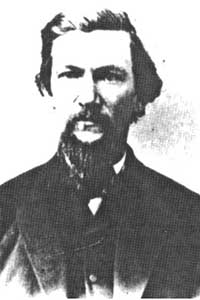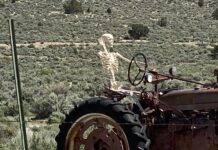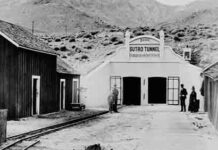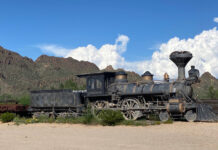by Dan De Quille
The Golden Era, December 6, 1863

If I had known that Mark Twain’s shirts were all without collars I would never have gone into partnership with him in rooms. I should have sternly refused having such a partner — all his excellent qualities and his useful little accomplishments, as those of foraging for little luxuries, and staving off the demands of our landlord for rent, I should have counted as naught — yea, as vanities.

Now, after much trouble I have succeeded in prying open his trunk, (why need he have left it locked, as though he had something in it?) all I found, fit for any white man to wear was one shirt, and it without a collar. I rejoiced then to think that I had broken the lock of his old Saratoga band-box. I spread out the shirt, pulled it this way and that — thinking the collar was turned down, or that it was fastened on in some outlandish place — half-way down the back, perhaps — for who could tell where such an oddity as Mark Twain might choose to wear his collars? I held it out at arms length by the sleeves and gazed on it — not a sign of a collar!
In the first outburst of my rage and disappointment, I threw the shirt as far as I could send it, flew at his old horse- hide-covered abortion of a trunk and kicked the lid and half of one side to pieces — though I have since repented somewhat of my hastiness, and tried to fix it up — exclaiming! “The vagrant hound! the deceitful wretch, to have a shirt in his trunk with no collar!”
Being somewhat exhausted with my efforts at kicking the old trunk, I seated myself on our washstand (Mark’s and mine) and counted one hundred twice over, when I grew calmer and began to see in its proper light the absurdity of my late proceedings.
From Silver Walled Palace, a collection by Dave Basso of mini masterpieces selected from more than sixty “Waifs from Washoe” De Quille sent to the Golden Era between December 1860 and January 1865. These sketches capture the tender and human side of the frontier life. His perception of the working of a silver mine and his characterization of a “mill warming” have created extraordinary institutions out of what would otherwise be mere daily routines in the life of a budding mining community. |
All I saw was not yet lost. I took another look at the shirt. It was as square off at the shoulders as though the last man who had worn it had had his head chopped off close to his body by old Hopkins’ bloody axe. While looking at the shirt, I discovered some buttons, which, I judged, were put in the peculiar position they occupied for the purpose of fastening a collar to the garment.
Elated by this discovery I rushed forth into the streets and of an accommodating Israelite procured the needed collar. Coming home, I managed by a strategic movement, or series of movements, to get into the collarless garment. Next I set to work to attach the collar. There was a button on the shirt somewhere back of my neck, on this I essayed to fasten the stiff, parchment-like collar. I tried for about six consecutive times — standing in front of our splendid (Mark’s and mine) oval mirror, twisting my neck till every joint in it cracked with trying to see just where that infernal button was — before I discovered that the button-hole in the collar was pasted tight shut with some kind of devilish glue.
I took the end of a pen-holder and pretty effectually opened it — I think so. Then I tried again to coax the
button to enter the breach; I got one edge of it through, got my finger firmly on the other edge — that was not through — then twisted my neck, raised up on the tips of my toes, made such horrible faces and rolled my eyes so frightfully that if I had not known for certain it was a reflection of my own face I saw in the glass, I should have sworn I beheld some poor fellow dying in an apoplectic fit.
After trying as long as I could stand on my toes, I let myself down and puffing and blowing for a few minutes, went at it again. I started the same way, only that after getting the edge of the button through I got my thumb nail firmly hooked under it — with my right thumb — thus gripping the part that was through and the fore-finger of my left hand pressing against the part that it was desirable to get through. I raised again upon the tips of my toes, holding my breath and quivering in every nerve — “spat,” something struck against the wall behind me, on the opposite side of the room.
About the same time my clutching fingers failed to find the button. I tried to twist my neck around sufficiently to see if it was really gone, or only hiding somewhere — I failed to either see or feel it, so I stopped and ruminated upon the matter. Remembering the sound I had heard, of something striking the wall, a light broke in upon me and going across the room I succeeded after a short search in finding the missing button, but of what use was it to me when I had neither needle or thread to re-fasten it?
Never mind, there is another button — a button in front. At it I go to fasten the two ends of the linen hoop to the front button. This, at the very first pass I make flies whizzing against the glass before me. I am mad then — I throw the crumpled bit of linen as far as I can send it and go — like a stray dog — without a collar. I feel like saying bad words, but as there are ladies in the rooms all about me, I dare not; so I seize my pen and write the sentences which commence this article, with “No Head nor Tail” for a head.
Don’t think from what I have said that I am hard up for shirts — we (Mark and I) have thousands of shirts, and we are going to get them all home one of these days — as soon as we get money enough. But I may as well, now that I think of it, tell you about our housekeeping.














